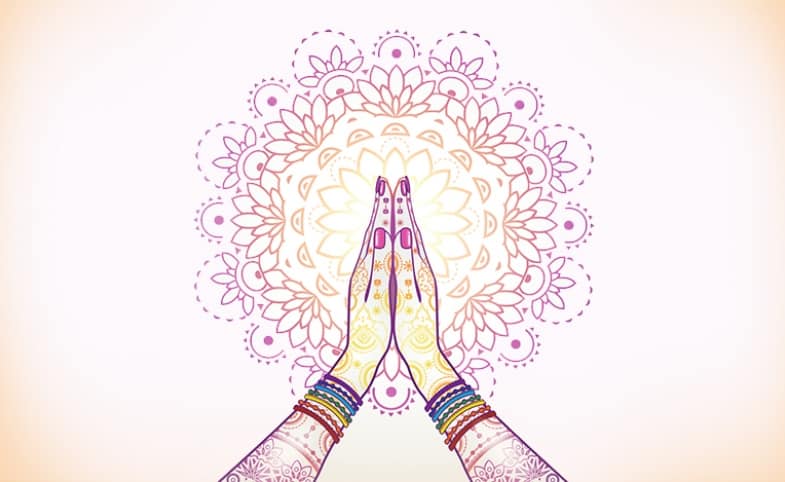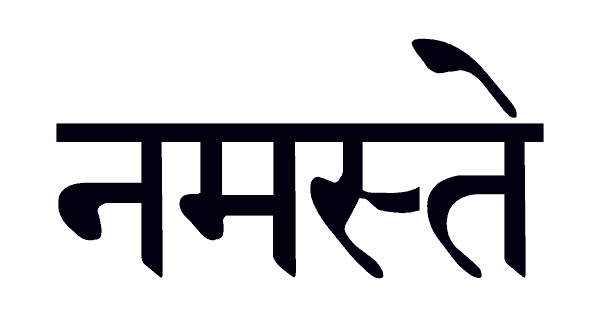Namaste meaning – Namaskar definition

What does namaste mean?
The literal translation of Namaste or Namaskar in Sanskrit is “to bow.” “I bow to you.” Yet the true meaning of this word, like most words in Sanskrit, runs much deeper than your average greeting.
The practice of yoga reminds us that we are all interconnected.
We are all unique, but simultaneously united in the human experience of emotions: upheaval, joy, sadness and peace.
By practicing yoga or pranayama (breath-work), we navigate away from the monkey-mind, swinging in the to-do lists of daily life.
Instead, we journey inwards toward the truest version of ourselves and the present moment.
If we think of our yoga practice as an exploration or inquiry of the present moment, we may be going through different things individually, but as a group, we are all united on the yogic path.
How does this connect back to Namaste?
Well, when a teacher uses the word Namaste at the beginning or end of a class, what she is saying on a deeper level beyond “I bow to you,” is that “when I (the teacher) am in a state of yoga, and you (the student) are in a state of yoga in you, we are one.”
In other words, we are all different, but being on the yogic path unites us.
Other translations of Namaste include the concept of “the divine light” that resides within each of us, and bowing to the innate goodness at the core of another person.
If you choose to think about yoga as a vehicle to reach your highest self or true nature, this definition may especially resonate with you.
From this perspective, Namaste might be translated as “the divine in me bows to the divine in you,” or “the light in me honors the light in you – in this place together, we are one.”
Saying Namaste is the traditional way to end class.
At a more practical level, it represents a teacher’s acknowledgement of her students.
As a teacher, she is not above or better than her students; she is an equal, who bows to the divine that resides in each of them. In saying Namaste back, the student echoes back gratitude for the teacher and all the other students in the room.
Gratitude for one another, the shared experience, and for the practice of yoga itself, is deeply embedded in this word.
Like so much of yoga and Sanskrit, the exact translation of Namaste can be left up to personal interpretation.
Create a definition of Namaskar that fits best with what yoga means to you and the value you receive from the practice.
Then say it with abundance (or choose not to) at the end of your next class.
Since the ways we can think about these Sanskrit words and what they mean are infinite, please share your thoughts on Namaste, Namaskar or your favorite definition in the comments below.
Also Read>>> What are the Yoga Symbols?
Some of us felt awkward the first time we put our hands together in a yoga class and said ‘Namaste.’
Over time it comes more naturally, but I still didn’t really know what I was saying for years.
Namaste meaning?

A simple definition for this Hindu greeting is “I bow to the divine in you.” When we bring our hands together, this is symbolic.
The left hand is said to represent the world of form, the right hand represents the unseen part of our reality.
When we bring our hands together before the heart chakra, we acknowledge that these dimensions are not separate.
We bow our heads and close our eyes in surrender, connecting through our hearts– not our minds.
At the end of class we say namaste, meaning ‘thank you, and the light in me honors the light in you.’
Through deeper yoga and meditation, however, we may discover an even more expansive way to define namaste, which cannot be fulfilled unless we are ‘awake.’
What is it to be ‘awake?’
The sages say it is difficult to talk about what it is to be ‘awake,’ because we awaken when we free ourselves from thought.
We understand by being it– not by knowing it.
Indeed, explaining an experience of awakening in words can be a bit like explaining the color green to someone who is color-blind.
This is why we ‘awaken’ through meditation; through examining our own experience, rather than through books.
We need to see “green” for ourselves; words are mere signposts to this experience. So how do we “see green” so to speak?
This is exactly what yoga and meditation are designed to do.
Both are aimed at bringing stillness to the mind and getting us into the present moment, which is where all the magic happens.
Also Read>>> What is the meaning of OM / AUM?
What’s so good about the present moment? Being a very mind-heavy person, I sometimes wondered why people made such a big deal about the present-moment.
I gave it so little attention that whenever I glanced at it, it seemed very shallow and 2-dimensional.
Boring, really.
Sure it’s nice to smell the roses, but surely the present moment is much less interesting than the elaborate virtual realities my mind had created out of the past and future.
Surely it is much less important than the empire of knowledge I had created about the world and how it works, right?
Wrong!

When we redirect the boundless resource of our attention away from the thinking-mind, and pour ALL OF IT into the present-moment, we might discover something astonishing:
The present moment contains everything you will ever need to know.
That is because it is in the present, and only in the present, where we can wake up to who and what we are.
How can meditation help us to do this? When we sit down to meditate, letting everything be just as it is, after time we may start to notice a space of awareness that is bigger than our thoughts, emotions, and sensations.
It is this space that does the watching.
At our barest essence, we are this space, because this silent stillness holds everything else.
Without thought soaking up our attention, we can give all our attention to this space of awareness.
We may find this awareness, this spirit, this “alive nothingness” is everywhere, and is in everything.
It is “me.” It is also “you,” and it is the trees and cities and oceans.
When experienced through the human heart, it is love and peace and joy.
We may eventually discover there is no separation between what is experienced and what is experiencing.
It is, we are, all One.
What does all this have to do with “Namaste?” This enlarged self-awareness is reflected in the longer translation, in which “Namaste” means: I honor the place in you where Spirit lives.
I honor the place in you where the entire Universe resides. I honor the place in you which is of Love, of Truth, of Light, of Peace. When you are in that place in you and I am in that place in me, we are One.
I sometimes heard snippets of yoga philosophy that claimed things like “the whole universe is in you” and “you are the whole universe,” and became very confused.
I’m only 168cm tall – how could it fit?
How could I be the whole universe, when I can only perceive a teeny tiny fragment of it?
It didn’t make any sense! But of course, I was thinking in terms of the world of thoughts and things.
The reason I can say “I am the universe” is that “I” am this vast awareness, distilled into a single point of view.
For me, I know I am “awake” when I recognize that the awareness that shines out of my eyes, is the same awareness shining out of yours.
Namaste Meaning – How to pronounce Namaste?
Simply : na·ma·stei and NOT : Nah-mah-stay
Here is the sound of Namaste from youtube
Conclusion | Namaste Meaning – What does namaste mean?
I am you, you are me. The light in me sees the light in you.
Or in other words, “Namaste.”



